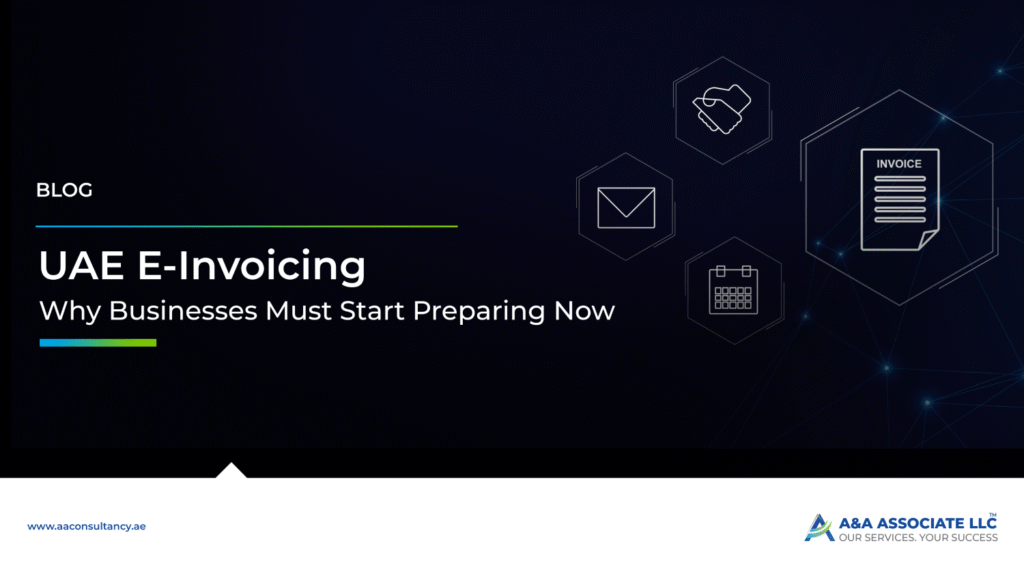E-invoicing will be mandatory for businesses in the UAE from July 2026, with the Ministry of Finance rolling out legislation throughout 2024 and 2025 to ensure the process is as smooth as possible.
Initially, e-invoicing will only be mandatory for B2B (business-to-business) and B2G (business-to-government) businesses. Both domestic and international transactions will be under the e-invoicing scope
What Is E-Invoicing?
A seller issues an electronic invoice to a buyer. The invoice follows a standardized format, and can be stored and automatically used for VAT purposes. This process is known as e-invoicing. If an invoice does not follow the mandated format, it will not be considered a legitimate e-invoice. So for example, if an invoice is in a PNG, JPG, or PDF format, it will be rejected.
What is an E-Invoice?
Below are the features of an e-invoice:
- Generated in JSON or XML format (must be machine-readable)
- Follows PINT (Peppol Invoice Standard) or UBL (Universal Business Language)
- Sent to the FTA through an ASP (Accredited Service Provider) using the Peppol network
Benefits of E-Invoicing in UAE
The implementation of e-invoicing in the country is hoped to reduce processing times and cut down on human error. The advantages of e-invoicing are:
- Cut down on VAT leakage: As data is sent to the authorities in real time, there are lower chances of tax evasion.
- Reduce invoice processing costs: By reducing dependence of paper invoices, e-invoicing cuts down on storage and related expenses.
- Increase compliance: E-invoicing minimizes the chances of tax evasion by making it easier to track transactions and reduces instances of fraud.
- Contributes to digitization: E-invoicing in the UAE adds to the country’s digitization efforts, making it more competitive by international standards.
UAE E-Invoicing “5 Corner” Model

E-invoicing in UAE is set to follow the Decentralized Continuous Transaction Control and Exchange (DCTCE) Model. The model has 5 steps, alternatively known as 5 corners:
- Corner 1: The supplier sends an invoice through their Accredited Service Provider (ASP).
- Corner 2: The ASP checks the invoice, certifies sender details, then transmits it to the buyer’s ASP.
- Corner 3: The receiving ASP sends it to the buyer after validating the data.
- Corner 4: The buyer receives the invoice through their preferred business software.
- Corner 5: The invoice is also sent to the FTA in real time by the supplier’s ASP.
Timeline
The UAE e-invoicing mandate is meant to be implemented from July 2026, but the process already started in 2024 with the accreditation of service providers. In 2025, the government is expected to introduce more legislation related to e-invoicing.
How Does E-Invoicing Affect UAE SMEs?
Small and medium-sized enterprises in the UAE are expected to benefit from the e-invoicing rollout:
- Automation can aid in increased VAT compliance
- Healthy cash flow due to quicker invoice validation process
- Digitally stored data aids deeper financial analysis and performance reporting
- Lowers security threats due to electronic storage
- Reduces misreporting, late submission, human error
How Can Businesses Prepare For the UAE E-Invoicing Mandate 2026?
Here are four ways your business can prepare for the upcoming e-invoicing rollout:
1. Start Ahead of Time
The easiest way to get ahead of the e-invoicing rollout is to start early. This can mean looking into other GCC countries (like Saudi Arabia) who have implemented it and learning from their mistakes.
2. Reach Out to Service Providers
Another important aspect of preparing for the e-invoicing mandate is picking an Accredited Service Provider (ASP). The Ministry of Finance has published several pieces of legislation about the accreditation process, so make sure you choose a provider that suits your business needs.
3. Invest in Training Your Employees
Making sure that everyone on your team is on the same page when it comes to understanding how to use the e-invoicing system and its features is essential to avoid compliance issues. You can do this by arranging workshops or integrating training sessions into their schedule.
4. Review Your Systems
Reviewing your existing software and invoicing systems to make sure they’re compatible with the e-invoicing mandate. Your IT team must conduct thorough and make the necessary changes to streamline the transition.
About A&A Associate
A&A Associate provides expert accounting services in Dubai, along with helping businesses and individuals manage corporate tax in UAE. They are also the largest business setup advisory in the country, helping entrepreneurs and investors with end-to-end business setup in Dubai.
FAQ's
From July 2026, e-invoicing will be mandatory in the UAE. All businesses will be required to generate electronic invoices to send to their customers through ASPs (Accredited Service Provider).
The accreditation process for the e-invoicing service provider has already been published in 2024, with more legislation being introduced throughout 2025. Phase 1 of the rollout is expected to start in 2026.
An ASP is an entity that is legally recognized and certified to handle e-invoicing in UAE. ASPs validate the details of the invoice and also send the information to the Federal Tax Authority (FTA).
The supplier or seller has to issue the e-invoice to the buyer. They must use an ASP (Accredited Service Provider) to do so.
E-invoicing is being implemented in the UAE to minimize instances of tax evasion and increase VAT compliance. Electronic invoices transmitted through ASPs will be sent to the FTA in real time.
The FTA (Federal Tax Authority), working under the Ministry of Finance will be the regulatory body responsible for e-invoicing in UAE.









